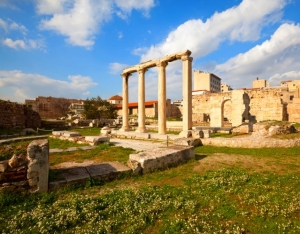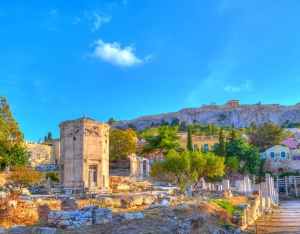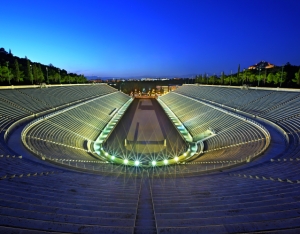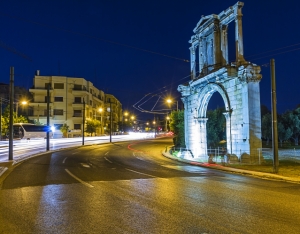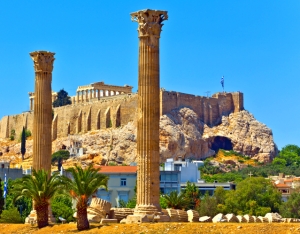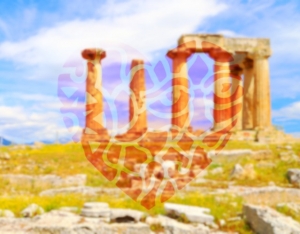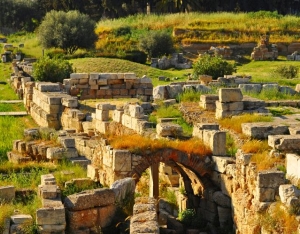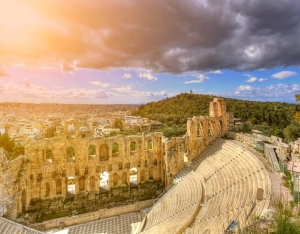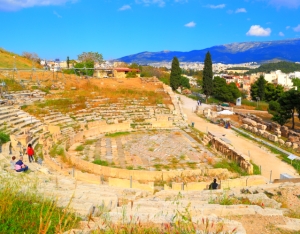Thodoris Bgenopoulos
In the heart of Athens, Monastiraki, are the ruins of the Library of Hadrian.
The Library of Hadrian was built, as its name hints, by the emperor Hadrian in 132 AD. Initially the building had a length of 130 m and width of 70 m, was possibly a three floor, while it was surrounded by an arcade with 100 marble columns. During its operation, The Library of Hadrian allegedly hosted over 20 000 parchments.
The library was destroyed by the invasion of the Heruli in 267 AD and about 400 AD it was repaired, while in the area Christian churches began to be built that do not survive today. During the Ottoman rule, it was the headquarters of the Turkish voivode, while after the Liberation, it was used as barracks and prisons.
Excavations began at the end of 19th century and continuing untill today. Nowadays, only the western part of the peristyle and its Corinthian columns is preserved from the Library of Hadrian.
Roman Agora (Forum) - Aerides (Tower of the Winds) in Athens
21 February 2015The Roman Agora is located in Plaka, the picturesque neighborhood just below the Acropolis. It was developed between 19 and 11 BC and gradually flourished due to Roman emperors' donations, euch as Julius Caesar and Hadrian. It was the commercial center of Athens in Roman times.
Within the area of the Roman Agora is one of the most distinctive buildings of ancient Athens, the Winds or more correctly the Clock Tower of the Winds. It is a marble building in shape of an octagon, with 12 m height, that was constructed by the astronomer Andronikos from Kyrros in the mid 1st century BC. In antiquity it functioned as a solar and hydraulic clock but also as a meteorological station, maybe the oldest in the world. The name Winds was given to the building by the inhabitants of Athens, because of the winds that were engraved and inscribed with their names in each of the eight sides of the building. At the top of the building there was once a vane and depending on its position, market traders and passers-by always knew what kind of wind was blowing.
A little further away from the Temple of Olympian Zeus, there is the Panathenaic Stadium also known as Kalimarmaro.
The first stadium to stand in this position was constructed around 330 BC and is used in the leading festival of Athens, the Great Panathenaia- Panathenaic Games. The shape of the stadium is typical of the time: a line with spectators seated on the three sides.
During the reign of Hadrian, Herod Atticus rebuilt the stadium, made the platforms marble (instead of wood) and expanded it so to fit 50,000 spectators. He also changed its shape, which became like a horseshoe, just as it is today.
During the Middle Ages the stadium was stripped of all its marbles and abandoned. In the late 19th century, when the Olympic Games were revived, the Panathenaic Stadium was fully reconstructed, funded by the national benefactor Georgios Averof, whose statue is now in front of the Stadium. The Panathenaic Stadium was built entirely from the famous Pentelic marble, so it is called "Kallimarmaro"(good-marble) and has a capacity of over 80,000 spectators. In 1896 the first Olympic games were held here, with Greek Spyros Louis being the first Marathon winner. Since then, the Panathenaic Stadium is used for a variety of sporting and cultural events. It goes without saying that every year here is the finish line of the authentic Athens Marathon, while several concerts have taken place here.
Next to the Temple of Olympian Zeus and towards the Acropolis is Hadrian's Gate. It was manufactured by the Athenians in 132 AD to honor the emperor Hadrian for the several developments he made in Athens. At the time of its construction it was a landmark between the old and the new city of Athens.
Hadrian's Gate combines Roman and Greek architecture, having the Roman arch at the bottom and the Greek portico at the top. It is 18 meters high and has a width of 13 meters.
The Temple of Olympian Zeus (also known as Temple of Zeus) is located southeast of the Acropolis at a small distance from the center of Athens. The location of the temple was chosen according to legend by Deucalion ,the founder of Athens, in honor of Zeus who saved him from the great flood.
The construction of the temple as you can see it today begun in the 6th century BC, upon the ruins of an older one, and was completed in the 2nd AD at the time of the emperor Hadrian, who inaugurated it.
The Temple of Olympian Zeus was the biggest in the world at that time, with a length of 110 meters and a width of 45. In its internal there were statues of Zeus and the emperor Hadrian.
The temple was of Corinthian order and consisted of 104 marble columns, of which only 15 survive today. The most recent is the fall of the 16th column during a storm in 1842. A few years later the Voivode of Athen, Tzistarakis, used pieces of the fallen columns to make lime and build the Tzistarakis Mosque in Monastiraki. These two events were considered a harbinger of bad news by the Athenians and were associated with the plague that struck the city in the coming year.
In Plaka, the neighborhood below the Acropolis, there is Tripodon street, where the Monument of Lysicrates lies. Constructed in 335 BC its is a sponsoring monument. But what was this really?
In ancient Athens, all costs for any theatrical performance werea ssumed by a wealthy Athenian citizen, named "sponsor". The sponsor of the performance that took the first prize was also rewarded with a tripod.
When the performance that was sponsored by Lysicrates won in a theatrical competition, he built this monument and placed the tripod with which he was rewarded on top, in commemoration of his victory.
The Monument of Lysicrates has cylindrical shape, six Corinthian columns and the frieze depicts a performance starring the god Dionysus. The monument is also known as the lantern of Diogenes (probably because the tripod on top looks like a lantern or perhaps from the ancient philosopher Diogenes, who walked around with a torch, searching--as he said--to find a real person). During the Turkish occupation the monument was incorporated into a monastery of Capuchin monks, which burned down completely but fortunately without the monument to suffer major damage. Today it is the center of the namesake square and is the best preserved sponsorship monument.
Between the streets of Ermou, Piraeus and Asomaton, you will find the archaeological site known as Kerameikos. It got its name from the pottery craftsmen who had settled there, at the banks of the ancient river Eridanus.
The area flooded frequently and was not suitable for houses, so it began to be used as a burial ground and gradually became the most important cemetery of ancient Athens.
Today in an area of about 40 acres, one can see scattered tombs and funerary monuments from almost all eras of ancient Athens, while many of the findings of the excavations can be viewed in the Archaeological Museum of Kerameikos. Here was created the "Dimosio Sima", the burial place of eminent Athenians and those who had been killed during war. It is believed that here Pericles, the famous Athenian leader, gave the renown speech 'Funeral Oration', honoring those who fell in the Peloponnesian War. The speech was rescued by the ancient historian Thucydides, while according to another version, "Epitaph" was written by the Thucydides himself.
In Kerameikos was also Dipylon, the main gateway to ancient Athens, and here was the startinh point of the famous Iera Odos(Sacred Way) that led to Eleusina.
The Odeon of Herodes Atticus (or simply Herodium) is right beneath the Acropolis, at the foot of the sacred rock. The odeon was built in the 2nd century AD, with money given by the rich Athenian Herodes Atticus in memory of his beloved wife Rigillia.
Herodion was used mainly for music events, was roofed with wooden ceiling and could accommodate 5000 spectators. It had 32 rows of marble stands, and a semicircular orchestra with three-storey stage building.
Probably the Odeon only worked for about a century, for it was also destroyed during the raid of the Heruli (267 AD). The roof burned completely and with the passage of time, dirt filled the bleachers.
Herodion was not restored until 1953. Since 1957 it hosts great cultural events, where renown artists from all over the world take part, while it is also hosts a part of the famous Athens Festival.
The Ancient Theatre of Dionysos used to be right beneath the Acropolis, at the foot of the sacred rock. The theater, which is the most important known theatrical space of ancient Athens, was founded around the 6th century BC and then took various forms over the years. The number of spectators that could be seated is estimated to surpass the 15,000.
This is the area where the Great Dionysia took place, being the most important celebration in honor of the god Dionysus. It is probably within these celebrations that all the works of leading ancient playwrights such as Aeschylus, Sophocles, Euripides and Aristophanes first appeared. The performances were watched all Athenian citizens and expenses were assumed by the more affluent , with so-called "sponsorship".
The raids of Silla (86 BC) and the Heruli (267 AD) did not leave the Ancient Theatre of Dionysus intact, so now only a small part of it survives.
At the edge of the Ancient Agora of Athens is the temple of Hephaestus, best known as Thissio. The temple was built between 450 and 420 BC in unknown architect plans and exemplifies the Doric order. It is also made from the famous Pentelic marble and the temple has a total of 34 columns (6 on the front and back and 13 on the sides). The fronts of the temple were decorated with themes from Greek mythology, including the labors of Hercules and the Athenian hero's Theseus (of which it is probable that it got the name Theseion-Thisio).
The Temple of Hephaestus is one of the best preserved temples in the world and to this probably contributed greatly the fact that it was converted into a Christian church (St George) in the 7th century AD, thereby avoiding total destruction. It is worth-noting that because during the Ottoman rule the operation of the church was prohibited (except once a year on the feast of the saint), the locals called it "Saint George Akamati".
In 1834 the welcome ceremony of the first king of Greece, Otto, took place in Thissio.

